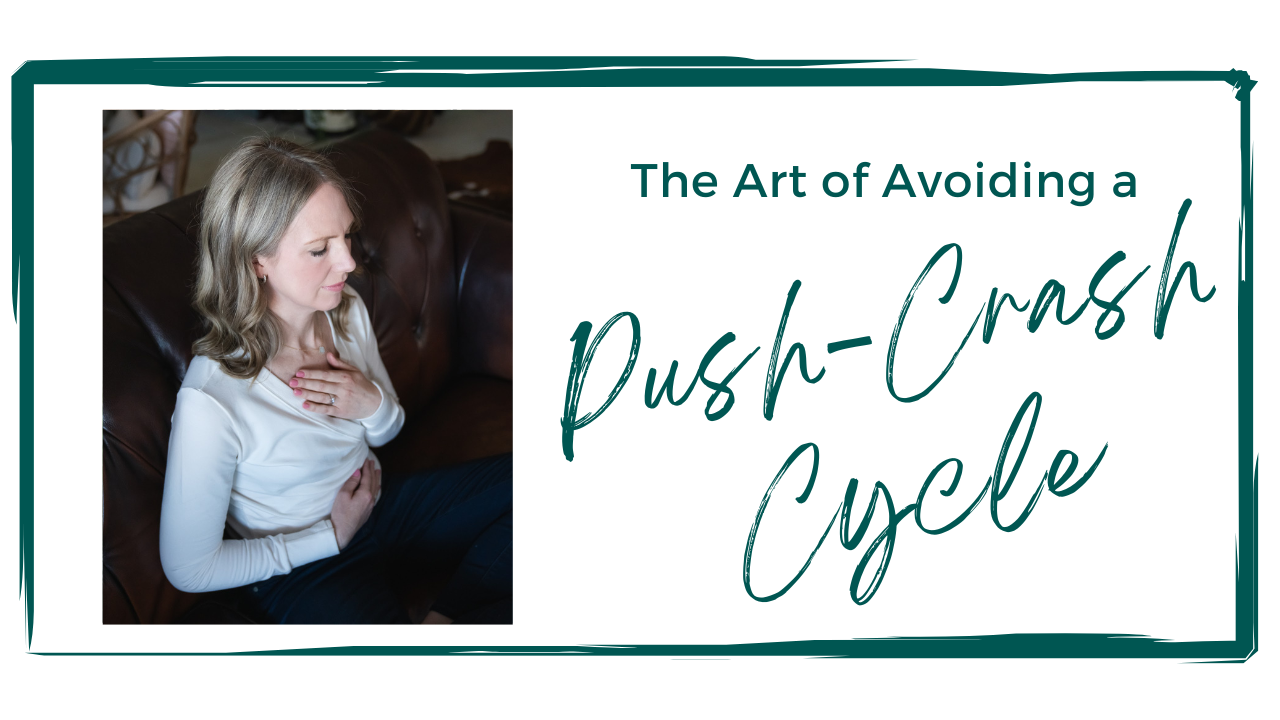The Art of Avoiding a Push-Crash Cycle
Nov 04, 2024
How to avoid workout “Push-Crash” cycles by learning when to either Pace or Push your workout.
When starting a new exercise program or amping up your current one, you may be faced with the dilemma of when to pace your workout and when to push your limits. This decision is individual, based on your current overall fitness level and personal goals.
So, how do you determine when to pace or when to push? In other words, when to support your body versus challenging it? When you are looking to support your body, it is to maintain your baseline of activities or get back to it. Challenging your body is improving your baseline activity. Your working level is your baseline—the level of activity your body can maintain without crashing—while your growth edge is where you challenge yourself without overdoing it. For individuals dealing with chronic illness, pushing too hard can result in a crash of debilitating symptoms extending far beyond typical soreness felt after a workout. It is crucial to avoid the "push-crash cycle" by learning to listen to your body and developing keen awareness of your body’s signals. The push-crash cycle, also known as boom-bust, often mirrors the habits of a weekend warrior—overdoing it when feeling good, only to face consequences later.
One useful framework for making this distinction is to categorize workouts based on their impact on the nervous system: Workouts to Support and Workouts to Challenge. The nervous system (NS) regulates many facets of our bodies and lives, influencing not just movement but also energy levels, digestion, and even healing. Instead of viewing flexibility, strength, and endurance in isolation, it's important to see how all systems work together as a whole.
Dr. Stephen W. Porges, founder of the Polyvagal Theory, explores how the autonomic nervous system continuously scans for safety or threat, influencing energy availability, healing, and overall well-being. His research highlights that when we feel safe and supported, our bodies can allocate energy toward recovery and function more effectively. Conversely, if we push too hard without adequate recovery, the nervous system may perceive this as a threat, leading to exhaustion and setbacks.
No two workout goals are the same. However, you can add prioritizing pain reduction, decreasing injury risk, or simply having enough energy for daily activities to your goal of working out. The key is to find a balance between relaxation and support on one hand and strength and activity on the other—finding that sweet spot between activity and rest, pace and push.
Regularly ask yourself: Is today a "pace" day or a "push" day? A "pace" day will help you maintain your working level, while a "push" day will help you expand your growth edge.
Rather than falling into the push-crash cycle, micro-exercising offers a way to stay within your working level while gently and safely progressing your growth edge with consistency. Consistency is more effective than intensity, leading to greater sustainability over time. These are short, intentional movement breaks designed to build stamina without triggering post-exertional malaise. By incorporating small, manageable amounts of movement throughout the day, you can maintain steady progress without the highs and lows of the boom-bust cycle.
Regardless of the exercise modality—be it Pilates, Yoga, or Strength Training—each can be adapted to either support or challenge your body. The focus should be on selecting the most suitable exercises and performing them in a way that aligns with your current energy levels and goals. So then the next question is, how do you create a workout plan based on energy levels that supports the nervous system?
Supporting Your Nervous System
Movements that support your nervous system are grounding, centering, and rebalancing. Choose exercises that nurture your energy, fostering a sense of safety, calmness, and revitalization. This approach involves not just what you do but how you do it.
- Touch: Gently patting, brushing, rubbing, and squeezing.
- Hear: Listening to quiet, calm music or natural sounds.
- Speak: Making sounds such as an audible sigh, chanting, and singing.
- Breathe: Utilize breathing techniques with longer exhalations, such as Straw Breathing.
- Move: Perform exercises at a deliberate pace or try gentle rhythmic movements like rocking and swaying.
- Time: Pause or stop before feeling tired or "worked."
Challenging Your Nervous System
Movements that challenge your nervous system are dynamic, off-balance, quick, and multidirectional. Opt for dynamic exercises that expend or burn energy, fostering a sense of upbeat safety and positivity. Similar to supporting exercises, the focus is not just on what you do but also on how you do it.
- Touch: Vigorous patting, brushing, and rubbing.
- Hear: Listening to upbeat, up-tempo music.
- Speak: Loud or fast sounds such as shouting or rapping.
- Breathe: Breathing techniques that get the blood pumping, such as Breath of Fire (Cleansing Breath).
- Move: Dynamic movements at a moderate or quick pace.
- Time: Build stamina and endurance.
Consider what you enjoy and find activities that don't feel like another to-do list chore. Recognize that your energy levels may fluctuate daily and determine whether you need to support or challenge yourself on any given day. Your working level is your baseline—where movement feels sustainable and steady. Your growth edge is where you enjoy just enough challenge without overdoing it.
Avoiding the push-crash cycle isn’t about doing less—it’s about doing what works best for you in a way that helps you feel good both today and in the long run. Be honest with your check-in—assess where you are, not where you think you should be. Next time you workout, check in with yourself: Are you pacing? Are you pushing? Find your sweet spot, and let that be enough.
Stay Connected
Learn to move and live with ease in a pain-free body:


